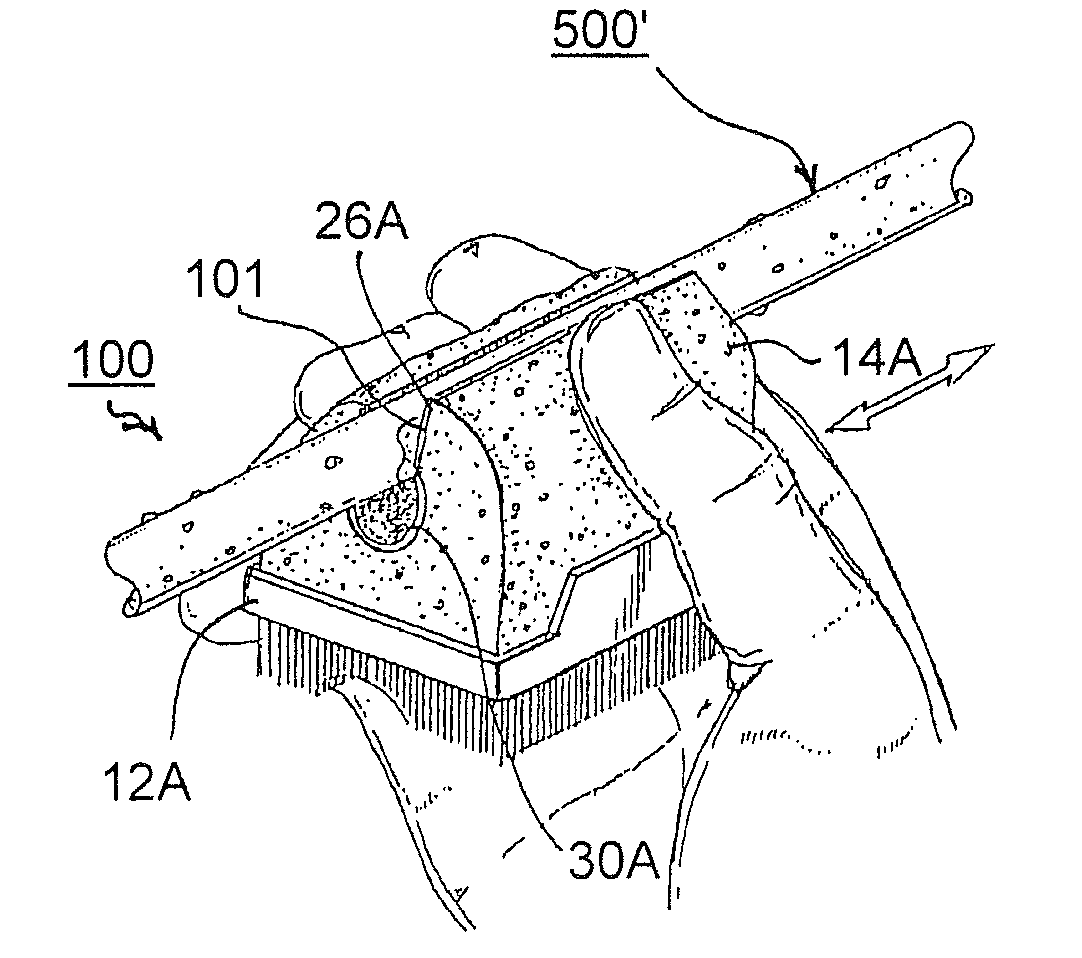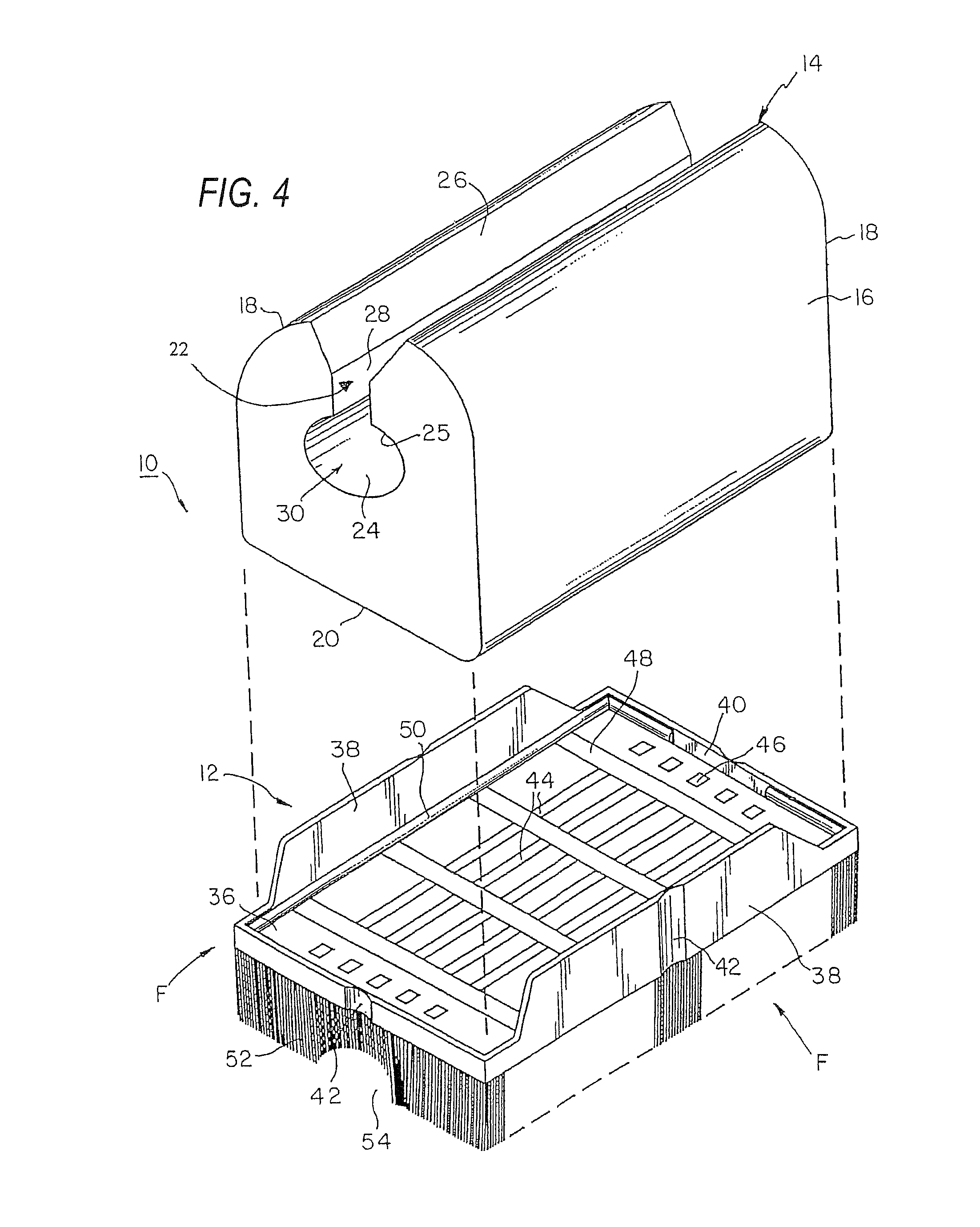Surgical scrub brush and cleaner apparatus
a scrub brush and scrub brush technology, applied in the field of scrub brushes, can solve the problems of ineffective cleaning process, less effective treatment, and unsubstantially modified scrub brushes used by medical professionals for quite some time, and achieve the effect of time-saving and efficien
- Summary
- Abstract
- Description
- Claims
- Application Information
AI Technical Summary
Benefits of technology
Problems solved by technology
Method used
Image
Examples
embodiment 100
[0054]As will be noted specifically in FIGS. 6 and 7, while it is preferred to position the annular surface of medical instrument 500 within inner channel 30A, the present embodiment 100, provides an extension of flexible material 101 along the angled regions and parallel wall regions 26A, 28A, as noted in FIGS. 6 and 7. Consequently, as noted in FIG. 7, where opposing forces F′, F′ is directly applied sponge member 14A molds itself to the annular surface for effective cleaning. It is also important to recognize that flexible layer 101 may also be effective at removing organic debris when used without abrasive material (grit) by the use of mechanical abrasion with the woven or non-woven synthetic material.
embodiment 200
[0055]Referring now to FIG. 8, an alternative embodiment of the present scrub brush-sponge member 200 is provided including a flexible layer 101 within a sponge member 214 bonded to a brush base 212. In the present embodiment 200, brush base 212 is provided with additional extension gripping wings 201 that extend from side walls 238 and may optionally include gripping bumps 202 or any other kind of gripping aid that is flexible (openings, studs, projections, ridges, etc.).
[0056]The present embodiment for scrub brush-sponge member 200 is provided as an additional force embodiment allowing a user to grip the entire sponge with annular surface within the central U or C-shaped channel and provide additional pressure with gripping wings 201. Gripping wings 201 are not provided with a complete closure of the sponge body 214 so as to allow sufficient flexible space before contacting in the middle during a use (See FIG. 7 for example). As a consequence, gripping wings 201 allow for addition...
embodiment 300
[0058]Referring now to FIG. 9, an alternative embodiment 300 is provided with a bottom sponge member 314 and a top sponge member 314A. A polymeric and flexible binding bridge member 315 having a premetral side wall 316 is provided for bonding top and bottom sponge members respectively. It will be recognized that bridge member 316 may be shaped similarly to the central support member of bottom brush 12 discussed above, but with bristles 52 being replaced by the foam brush shaped as shown.
[0059]In the embodiment shown in FIG. 9, bottom sponge member 314 includes the flexible layer 101 along the C-shaped region 317, and an opposing U-shaped region 318 is formed in top sponge member 314A without a flexible layer 101, although a flexible layer may be provided in U-shaped region 318 without departing from the scope of the present invention. Consequently, embodiment 300 is provided with two opposing regions for scrubbing the annular surface of medical instrument 500, either or both of whic...
PUM
| Property | Measurement | Unit |
|---|---|---|
| flexibility | aaaaa | aaaaa |
| flexible | aaaaa | aaaaa |
| external compression force | aaaaa | aaaaa |
Abstract
Description
Claims
Application Information
 Login to View More
Login to View More - R&D
- Intellectual Property
- Life Sciences
- Materials
- Tech Scout
- Unparalleled Data Quality
- Higher Quality Content
- 60% Fewer Hallucinations
Browse by: Latest US Patents, China's latest patents, Technical Efficacy Thesaurus, Application Domain, Technology Topic, Popular Technical Reports.
© 2025 PatSnap. All rights reserved.Legal|Privacy policy|Modern Slavery Act Transparency Statement|Sitemap|About US| Contact US: help@patsnap.com



